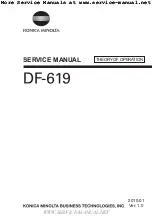
MILL HAMMER ROTATION OR REPLACEMENT
SERVICE
MILL THROAT PLATE
The mill throat plate must be properly adjusted to hold the screen in place when the mill screen cover is
closed and latched. Adjust the throat plate position with the 2 bolts on each side of the mill housing. To
adjust the throat plate;
-35-
NOTE:
Use a catch pan or install a small screen below the rod for the hammers and spacers to drop into
as the rod is being pulled out.
IMPORTANT:
Hammers and spacers must be replaced in proper sequence with respect to the
appropriate row on the cylinder. When the hammers are rotated they should always be rotated in the
same direction to maintain a balanced cylinder. All 3 rows of hammers should be rotated at the same
time or replaced at the same time.
After the hammer rod is replaced and all of the hammers and spacers have been replaced, secure the
rods in place with a new 3/16 x 1-1/4" cotter pins. Spread the points and bend them around the rod.
Replace the access hole cover.
To maintain maximum grinding efficiency, the mill hammers
should be rotated before wear radius measures ¼” (6 mm).
Mill hammers are designed to be conveniently removed and
rotated through 4 positions, before they require replacement.
The hammers should be replaced when all four corners are
worn to ¼” (6 mm) radius.
The mill cylinder contains 3 rows with 22 hammers in each
row. To remove a row of hammers, rotate the cylinder to the
position where the row of hammers to be removed lines up
with the access hole in the left side of the mill housing. With
the access hole cover removed, pull the cotter pins out of the
ends of the hammer rod and pull the rod out through the access
hole.
1. Disengauge PTO and shut-off tractor.
2. Open the mill screen cover and install a screen into the
screen support.
3. Loosen, but do not remove the 4 adjustment bolts and
position the throat plate toward the bottoms of their
mounting slots, then partially tighten the bolts.
4. Close the mill screen cover while forcing the screen
against the throat plate.
5. Before latching the cover, tightly secure the 4 adjustment
bolts to lock the throat plate position.
NOTE:
The throat plate position should be adjusted regularly to maintain proper mill/screen operation
and cover latching, and to prevent material from dropping out the bottom of the mill.
Summary of Contents for GM 170
Page 6: ... 4 ...
Page 8: ... 6 ...
Page 11: ... 9 SAFETY INFORMATION ...
Page 12: ...SAFETY INFORMATION 10 ...
Page 13: ...SAFETY INFORMATION 11 ...
Page 14: ...SAFETY INFORMATION 12 ...
Page 16: ... 14 ...
Page 53: ...SERVICE PARTS NOTES 51 ...
Page 81: ... 79 ...
Page 82: ...FIGURE 20 OPTIONAL LIGHTS FENDER 1 2 3 4 5 6 7 7 7 7 8 8 9 9 10 11 11 12 80 ...
















































